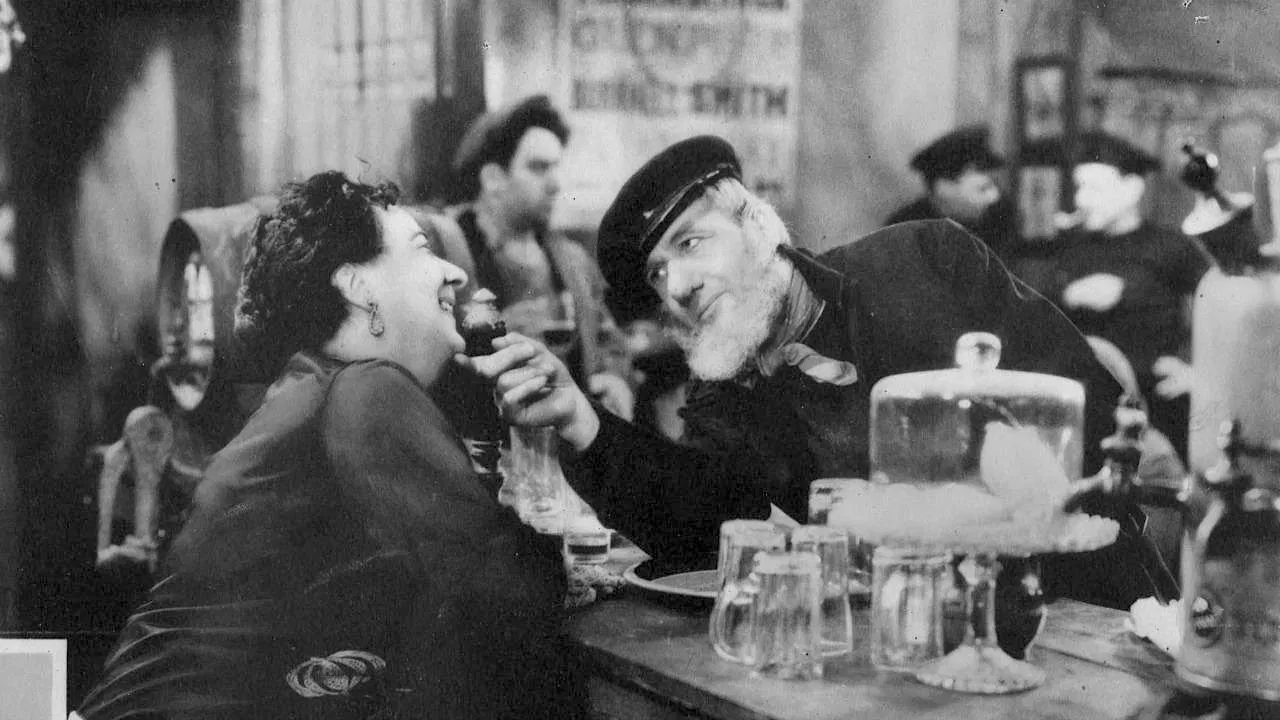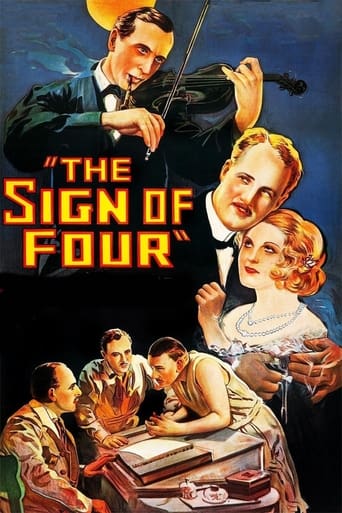

I like Arthur Wontner's portrayal of the great detective Sherlock Holmes. He is not as flamboyant and arrogant as Basil Rathbone's Sherlock but Wontner is still fun to watch - just not nearly as fun as Rathbone.This movie starts out with a backstory where we what happened years before the current time the film is set in. We witness a death and robbery of treasure, then we fast-forward a few years to see what the past has lead to and Sherlock Holmes being called in on the case. Due to this, quite a bit of the mystery is taken away from the story because the viewer knows quite a bit already but not all of the mystery is completely taken out of the story so we are still left with a fun Sherlock Holmes film to view.Overall I was entertained by the film, I found myself giggling as some of Holmes' subtle jokes and the bumbling police.8/10
... View MoreThe process of dragging the Victorian character Sherlock Holmes into modern times had commenced already by 1931, when Arthur Wontner played Holmes for the first time in SHERLOCK HOLMES' FATAL HOUR. Between then and 1937, he made four more Holmes films, this being the third film of the total of five. The setting is firmly contemporary. Dr. Watson (played feebly by Ian Hunter) makes a phone call from a public telephone box, and when he and the girl (played by Isla Bevan with one of those ridiculous wobbly voices, in between ludicrous fainting fits) visit a circus or fun fair in the dangerous area 'behind Kings Cross' in London, we see kiddies driving electric dodgem cars. However, the atmosphere of the film is firmly Edwardian, verging on Victorian, and the stuffy manners of all the characters are from such a distant past that even Conan Doyle might have been embarrassed by them. Despite all of these factors, this is a charming glimpse of a lost era of incomprehensible manners and pathetic flirtations, of drooping victim girls and pompous oaf police chiefs. Arthur Wontner plays Holmes with an arch and knowing air. He is convincing enough to make the films watchable. This is a film for people who like watching vintage Sherlock Holmes films, and there are plenty of such folk, amongst whom I from time to time may also be numbered. The villains of the film are perhaps the best cast, such as Roy Emerton with his wonky eyes and deadpan crook's manner. This was only the second feature film in which he appeared, but already he was a born classic character actor. He appeared again with Wontner as an arch villain in THE TRIUMPH OF SHERLOCK HOLMES in 1935. Emerton died in 1944 at the early age of 51. He had been a soldier in World War I, and variously also a stevedore, a cowboy, a fireman, a railroad worker, and a miner. They don't train character actors like that anymore! He appeared in 34 films and added authenticity to them all, I am sure. Perhaps his most unlikely part was as Octavius in Josef von Sternberg's I, CLAUDIUS (1937), which I have not seen.
... View MoreIt's an imperfect telling of the tale -- and a truly lousy print -- but entertaining nonetheless. The script spends too much of the running time on two hoodlums who are after the Rajputana pearls or whatever they're called. Good thing they're Indian, not Italian. And too much time on innocent young Mary Morstan in her flower shop. Holmes and Watson don't appear until about twenty minutes into the film. In the story as written, she simply shows up at 221b Baker Street because she's puzzled about the gifts of pearls she's been receiving. But at least, in this movie, the escaped Andaman convict, Jonathan Small, has his lengthy back story shown in a brief prologue, so that's gotten efficiently out of the way. The rest of the film follows roughly in the footsteps of the printed tale. Holmes and Watson pursue a stolen treasure that's in the hands of the two goons and their curious friend. Holmes makes some fantastic deductions that not even Conan-Doyle would have dreamed up. He infers from a man's penmanship that the writer had only one leg. Credo quia absurdum. But he gets one thing right when he deduces from a footprint that the foot had never worn shoes. I spent two years on a small Pacific island and it was almost immediately apparent whether the marks of bare feet in the sand had been left by natives or tourists.For those of us accustomed to a Sherlock Holmes that looks and acts like either Basil Rathbone or Jeremy Brett, Arthur Wontner is a strange specimen. He LOOKS like the Paget drawings! And in profile he strongly resembles Rathbone. But he's also shorter, like Brett. And, like neither of his two famous successors, he moves lazily, casually, stiffly. And his chief weakness is his voice. It's rather mousy and pinched. It sounds as if it's HE who should be behind the counter in that florist's shop, not Mary Morstan.Watson is Ian Hunter, better known as Richard the Lion Heart in "The Adventures of Robin Hood." As one of the Sholto brothers, Miles Malleson is incredibly youthful and looks something like Alfred Hitchcock. No one else in the cast stands out except Thug Number Two, a tattooed giant of a man who could take Mike Mazurki apart.I've sort of made fun of it but I shouldn't be too harsh on the movie. It was hard to produce a sound movie with any dexterity in 1932 because of technical limitations. You can see some obvious examples in the movie. But it is, after all, Sherlock Holmes and, unlike the updated versions from Universal Studios in the 40s, this one tries to show us something of the original story.
... View More(Some Spoilers) Feeling guilty and having an attack of the shakes with the knowledge of one-legged master criminal Johathan Small,Graham Sutten, breaking out of prison old and infirmed. Major john Sholto,Herbert Lomas, calls his two sons Thaddeus and Bartholomew, Miles Malleson & Kynaston Reeves, into his study and tells them a story about his dark past that he kept from them all these years.The Major is a both thief and murderer who killed his fellow British officer Captain Monstan, Edger Norfolk, back in India when they discover a buried treasure chest of jewels and pearls in an empty and abandoned ancient castle.Given instructions to the buried treasure by interned British solider Small Major Sholto not only murdered his partner Captain Monstan but left Small out in the cold and behind bars, whom he promised to left go free, taking all the loot for himself. Now feeling that the end is near and wanting to clear his conscience Major Sholto instructs his sons to return the treasure to the deceased Captain Monsta's daughter Mary, Isla Beuan. A florist in London's Weat End district. The end comes sooner then Major Sholto thought when Small pops up in his window which causes him to suddenly die of a heart attack. Small getting together with a gang of weirdos that he recruited out of the local circus the Tattoed and Tonga the Snake Man, Roy Emerton & Toga, plan to get Major Sholto's treasure by first finding out when he hid it from his sons Thaddeus & Bartholomew. Then get Mary to give him the pearl necklace that the deceased major mailed to her just before he died. After a close call from The Tattoed Man, who came to her store to buy flowers, Mary goes to private detective Sherlock Holmes, Arthur Wontner, for help and protection which she gets but also falls in love with his friend and assistant the dashing and dynamic Dr. Watson,Ian Hunter, as an extra bonus.Early Sherlock Holmes movie with a witty and super observant Holmes, the guy can tell if someone is missing a limb or not just by studying his handwriting, using both his brains and his boxing skills, Sherlock throws a really wicked left hook, to solve the case and save the girl from a bunch of murderous villains. The Small gang take out brother Bartholomew with a blow gun, curiosity of the Snake Man Tonga, after getting the information from him where the treasure was hidden by his late dad Major John Sholto. But Small is still not satisfied and wants the pearl necklace that's with Mary who's being protected by Sherlock Holmes and the London PD. Kidnapping Mary the trio of criminals, Small The Tattoed and Snake Man, make it to the London docks. There together with their contact to get them out of the country warehouse and speedboat driver Mordecai Smith, Moor Marriott,race up and down down the Thames ending in a free for all at Smith's warehouse. With the one-legged Small disappearing under the waves. In the end Shurlock Holmes as usual ends up solving the case and getting his man, or men, but it's the usually bumbling and fumbling Dr. Watson who end up getting the girl.
... View More